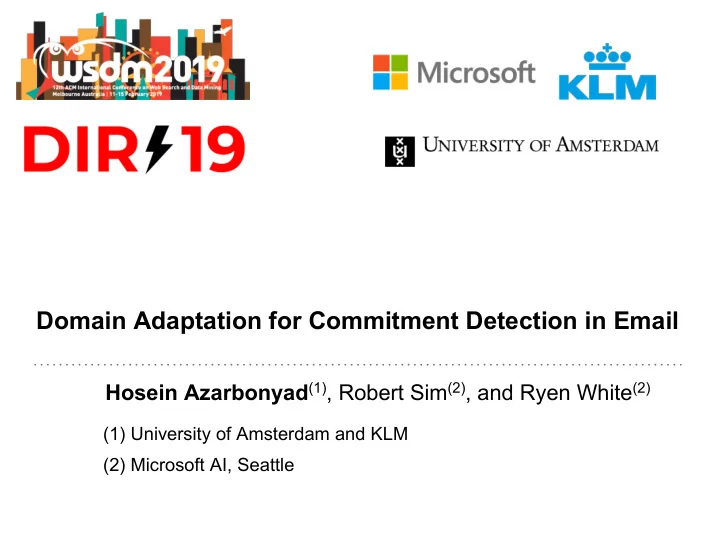

Domain Adaptation for Commitment Detection in Email Hosein Azarbonyad (1) , Robert Sim (2) , and Ryen White (2) (1) University of Amsterdam and KLM (2) Microsoft AI, Seattle
WHAT IS COMMITMENT? ➤ Any sentence in email where the sender is promising to do an action which can potentially be added to his/her TO-DO ➤ list (eg. sending a document) can be worthy of a reminder (e.g. meeting a colleague) ➤ 2
WHY COMMITMENT DETECTION IS IMPORTANT? ➤ People use emails not only as a communication tool, but also as a means to create and manage tasks ➤ Automatic task management systems can assist users manage their tasks more efficiently ➤ Commitments are often hidden in emails and users struggle to recall and complete them in a timely manner 3
COMMITMENT DETECTION ➤ Commitment detection is a challenging task Challenge1: There is no publicly available large-enough dataset for this task Challenge2: There is a domain bias associated with email datasets 4
DATASETS ➤ We crowd-source a set of samples from Enron and Avocado and collect commitment labels The statistics of commitment datasets The most informative Enron features regarding the positive class 5
CAN COMMITMENTS BE RELIABLY DETECTED? ➤ In-domain performance of a logistic regression classifier ➤ Task Binary classification ➤ Classify if the sample constitutes any commitment ➤ Features: word n-grams ➤ The commitment model achieves a reasonable performance 6
COMMITMENT DETECTION ➤ Commitment detection is a challenging task Challenge1: There is no publicly available large-enough dataset for this task Challenge2: There is a domain bias associated with email datasets 7
PERFORMANCE OF COMMITMENT MODELS ACROSS DOMAINS ➤ Performance of commitment models degrade significantly when moving across domains ➤ We cannot reliably train a model in one domain and use it to detect commitments on a different domain 8
DOMAIN BIAS IN EMAIL DATASETS AND MODELS ➤ Most email-based models are derived from public datasets, which are skewed in a variety of ways different organizations with very different and specific focus areas ➤ ➤ being old and adding an element of obsolescence ➤ different named entities and technical jargon Our goal : Using transfer learning for transferring knowledge learned in one domain to other domains and achieve more robust and generalizable models for commitment extraction 9
DETECTING COMMITMENTS ACROSS DOMAINS ➤ Feature-level transfer learning Feature selection ➤ Feature mapping ➤ ➤ Sample-level transfer learning Importance sampling ➤ ➤ Deep autoencoder 10
DEEP AUTOENCODERS: OBJECTIVE ➤ Goal : to achieve a domain independent representation for samples optimized for the commitment detection task ➤ Objectives Achieve a good representation for samples: the representation should capture the core and ➤ essential parts of the input sample Conventional reconstruction loss ➤ Achieve a good performance in commitment detection task ➤ Commitment classification loss ➤ Remove domain bias ➤ Domain loss ➤ 11
DEEP AUTOENCODERS: ARCHITECTURE OVERVIEW Loss Loss Reconstruction Loss Domain Loss Classification Loss Output Seq. Sigmoid Sigmoid Output module Decoder Non-linear Non-linear Sample rep. Sequence to Sequence Encoder … Input module Embedding Projection … Input 12
AUTOENCODER RESULTS ➤ Proposed AE outperforms IS method significantly over all datasets ➤ All loss functions contribute to the performance of the AE method 13
CONCLUSIONS ➤ Commitments can be reliably detected in emails when models are trained and tested on a same domain (dataset). ➤ However, their performance degrades when moving across domains ➤ Domain bias can have a big impact on the performance of commitment models and email models in general ➤ We can detect and characterize this bias from email datasets ➤ This characterization can be used for training reliable and generalizable commitment models 14
Thank You! Hosein Azarbonyad @HAzarbonyad hosein.azarbonyad@klm.com 15
CHARACTERIZING DIFFERENCES BETWEEN DOMAINS The Precision-Recall curve of the domain classifier (predicting which domain the samples come from) The most informative unigram features indicating the Enron domain 16
CHARACTERIZING DIFFERENCES BETWEEN DOMAINS ➤ Can we use the characterization between domains to train domain-independent commitment models? ➤ All transfer learning approaches improve the performance of LR model ➤ More improvements for Enron->Avocado Enron samples are more biased and domain specific ➤ 17
AUTOENCODER RESULTS ➤ How much data does AE need in the target domain to achieve a good performance? 18
Recommend
More recommend